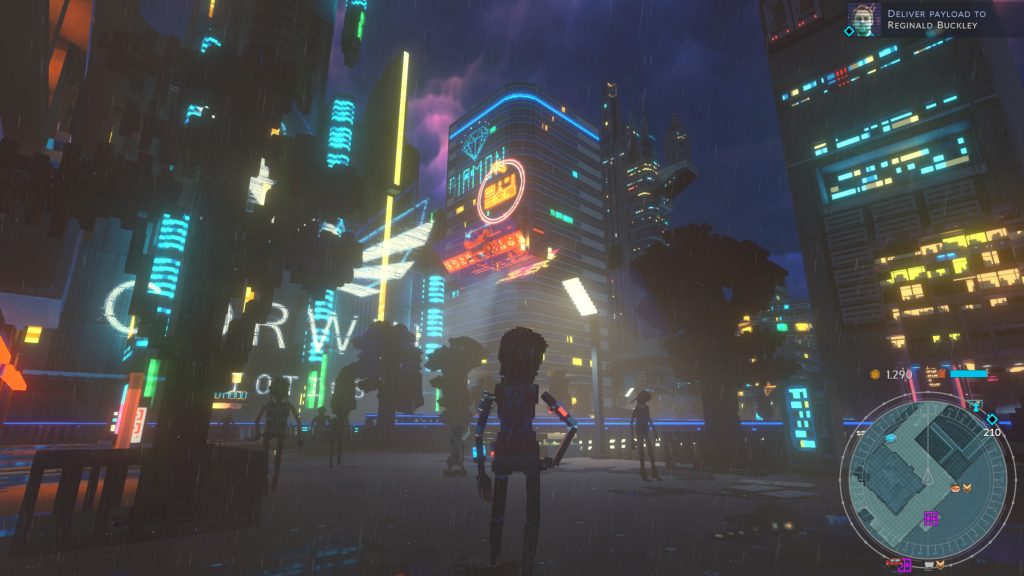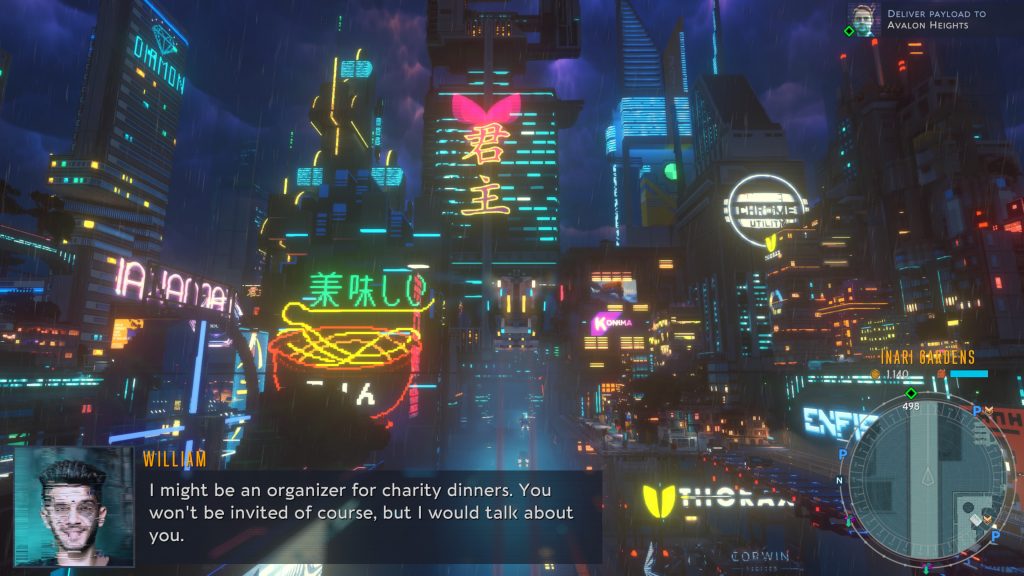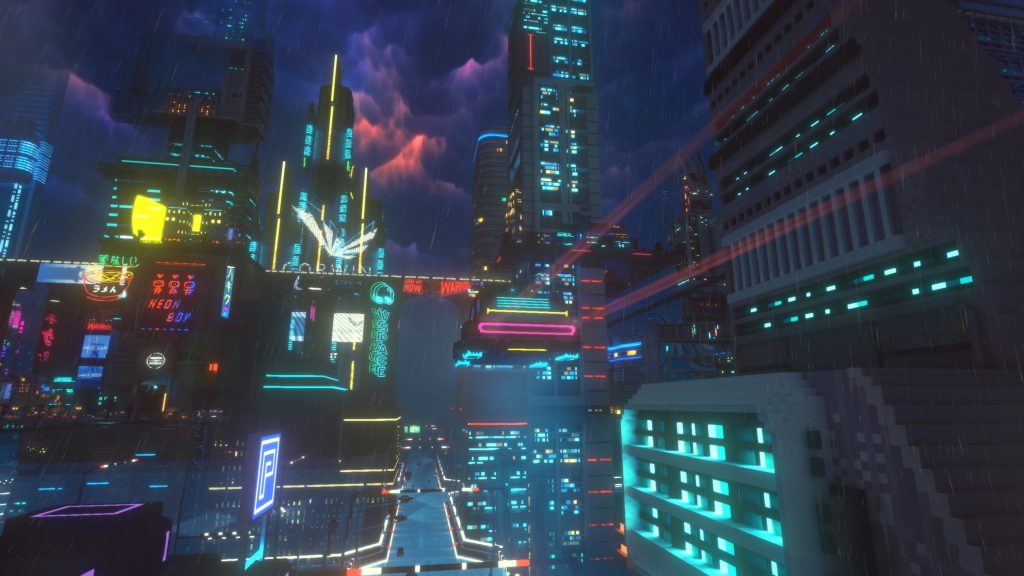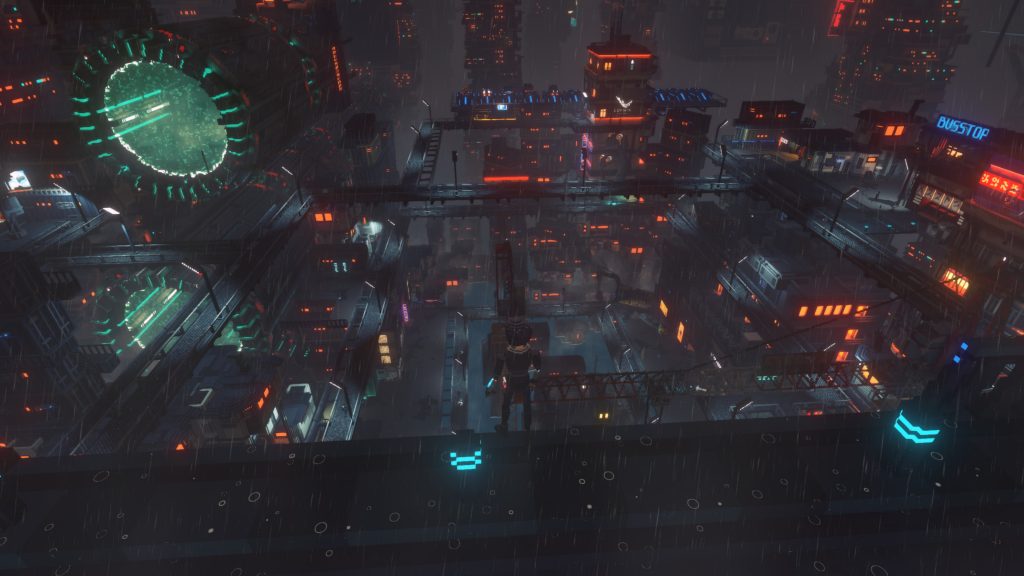It’s my first day as a Cloudpunk driver. I’ve already been involved in a bombing (potentially), met a mad, ancient AI who may or may not be causing the city of Nivalis to collapse, and delivered pizza worth my monthly salary to a pineapple-hating CEO. There are only two rules – don’t ask what’s in the package, and deliver it on time. Everything else? Guidelines. Just guidelines.
Cloudpunk is all about the story, forming in bite-sized pieces as you hop from delivery to delivery. Nothing is as simple as it seems, and yet, at the same time, it’s only as complex as you want it to be. It’s so easy to zone out navigating the incredible cyberpunk city ION LANDS have crafted, taking in the rain, the neon, the ambient sounds of an impossible metropolis. Nivalis stretches up high and plunges low, and by the time the story ends, you’ll have seen both of those extremes.

You’ll pick up a package and take it to the destination. Delivery requires you to get out of your vehicle and explore the city on foot, sometimes solving minor environmental puzzles to reach the destination. As you make your way to the target, you can take in stories from Nivalis’ colourful inhabitants – android street gangs sticking it to the man by planting trees, other lost souls like our heroine who came to this place simply because they had nowhere else left. Sometimes you’ll stop off for coffee or a quick meal. Sometimes you’ll get dragged into dangerous situations.
It can be quietly comical, or surprisingly poignant. Rania (the protagonist) is very human – she knows she just needs to get the job done, but she has a moral bedrock beneath it all. Her morality and background is explored through Camus, a dog automata personality loaded into her car, and the mysterious voice of Control. Control is the guy who gives you your jobs, and we go on such a surprising journey with what seems like a very generic character at first. These two characters seem to represent the two sides of Rania – Camus being idealistic and wanting to do the right thing, and Control believing that lofty concepts like ideals mean little when it comes to survival.

This is Cloudpunk‘s core theme. It’s a game of choices. At times you’ll be asked to make choices – deliver the package, or throw it in the bin. Eventually these become more complex – one sequence sees Rania heading to a quarantine zone with authorisation to rescue three people, having to decide between the people who would do the most good or the people who’d make you the most money. The story will still proceed in the same way, but your actions will come back to haunt you. The game’s ending sequence is basically Rania facing up to the consequences of her choices in one last tour of Nivalis.
It’s actually incredibly easy to forget that Nivalis and its inhabitants are all portrayed in voxel art, and this may well be because of the combination of neon and gloom. Nevertheless, Cloudpunk is an absolute treasure to look at. I really can’t give the graphics enough credit, they’ve done an absolutely phenomenal job with relatively simple tools. This approach has allowed them to create a city with unrivalled depth and visual flair. Cloudpunk is probably the best cyberpunk experience I’ve had besides Blade Runner.

It’s an easy game to play, sure. Besides a few limited instances, you’re never actually timed on anything, so the only real threat is navigating your clunker of a flying car through traffic without hitting everything on the way. Your HOVA can take damage, but this isn’t actually indicated anywhere on screen (something the City of Ghosts DLC has addressed, thankfully). So when you’ve taken enough hits, you’ll simply get an onscreen quest message telling you it’s time for repairs.
I’m not entirely convinced the damage mechanic was necessary. So much of Cloudpunk‘s strength comes from its storytelling, and you already have to stop off for fuel at regular intervals, which grounds the experience perfectly. Flying around Nivalis is an enthralling experience – the city swallows you at every turn. You can fly along “roads” which allow you to fly faster but will be dense with traffic in all directions, or you can go off the grid, flying slower but with a bit more freedom to move.
Navigating the city effectively requires you to mix both of those movement styles. Use the roads to get as close to your target as possible before breaking off and making the rest of the journey off-grid, before parking your HOVA and going on-foot. It’s possible to just charge through all the story missions, stopping off every now and then to install new vehicle upgrades, but it’s just as feasible to ignore them entirely and roam around the city talking to people.

Completing the story missions can feel like a bit of a drag sometimes. There are often awkward pauses for dialogue where the map hasn’t yet updated with your destination, so you have to choose between flying around aimlessly (possibly further from your target, burning fuel the whole time) or pulling off the road and remaining stationary somewhere. It’s a minor gripe, especially when the story it stops to tell is so often compelling.
Cloudpunk: Rate your delivery!
Cloudpunk is an incredible experience in a subtle package. It won’t blow your mind in a dramatic fashion, but it will make you think. It might even help you relax – drifting around Nivalis’ dystopian ambience is strangely soothing. This is such a strong game, packed with exploration, quality writing and emotional nuance. It can be enjoyed in bits and pieces or long, absorbing sessions, which is a real testament to the game’s design.
I have no real complaints about Cloudpunk. It’s a thoughtful marvel that deserves all the attention it gets. I can’t wait to dive into City of Ghosts for our review next week, and I’m even more excited at the prospect of Nivalis, their upcoming cyberpunk life-sim set in the city. If you really want to get lost in the dark future, play Cloudpunk.
Cloudpunk and City of Ghosts are available on Steam now. Check out more of our game reviews here.